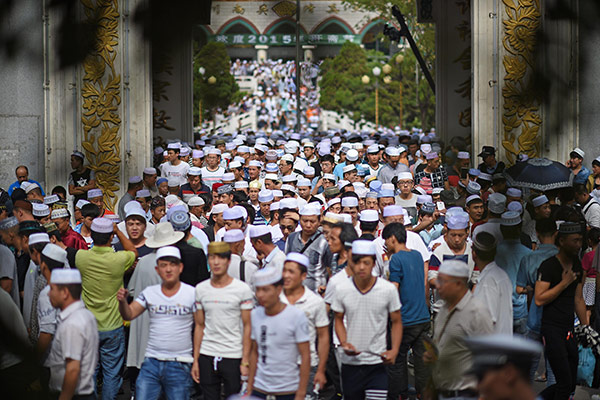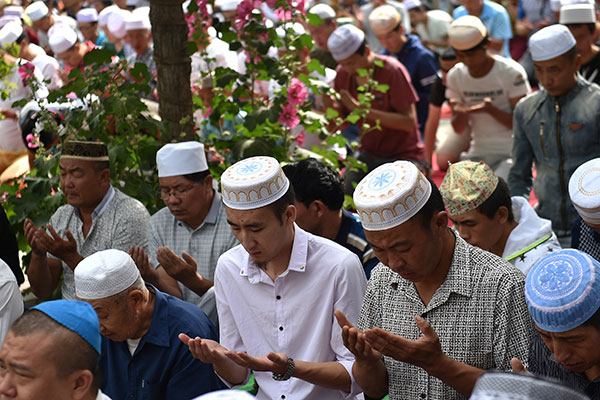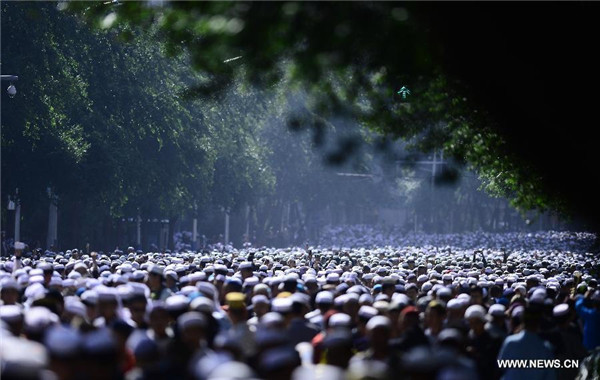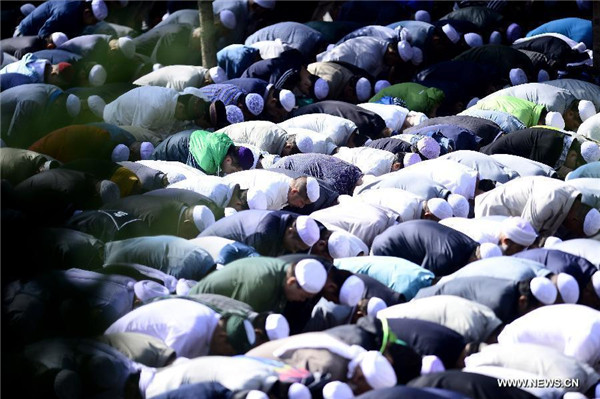
Muslims leave after gathering to pray during the start of the Eid al-Fitr which marks the end of Ramadan at Nanguan Mosque in Yinchuan, capital of Northwest China’s Ningxia Hui autonomous region, July 18, 2015.[Photo/Xinhua]
YINCHUAN/URUMQI — Muslims across China on July 18 celebrated Eid al-Fitr, which marks the end of the Islamic holy month of Ramadan.
In Yinchuan, capital of northwest China’s Ningxia Hui autonomous region, Na Jinzhu arrived at the Najiahu Mosque early in the morning with his son and granddaughters.
“Ramadan is the most auspicious month in the year,” said the 65-year-old man. “I took my granddaughters here so that they could learn about our religious traditions from an early age.”
Ningxia is a major region for China’s Hui Muslims, who account for 35.7 percent of the region’s total population, or 2.36 million people.
Li Jianhua, Communist Party chief of Ningxia, conveyed festive greetings during a gathering with Muslims in the mosque with a history of 490 years.

Muslims gather to pray during the start of the Eid al-Fitr which marks the end of Ramadan at Nanguan Mosque in Yinchuan, capital of Northwest China’s Ningxia Hui autonomous region, July 18, 2015. [Photo/Xinhua]
A five-day holiday begins on July 18 in Ningxia. Highways and most scenic spots will be free of charge during the holiday.
In Beijing, roads were temporarily closed near the Niujie Mosque in downtown for a celebration of tens of thousands of Muslims.
Many people had their photos taken outside the mosque, including a woman surnamed Liu, who came from neighboring Hebei province especially for the occasion.
“The atmosphere is more festive here than in our hometown,” she said.

Muslims gather to pray during the start of the Eid al-Fitr which marks the end of Ramadan at the Niujie Mosque in downtown Beijing, July 18, 2015.[Photo/Xinhua]
In Xinjiang Uygur autonomous region, senior officials shared iftar with Muslims for the celebration of Eid al-Fitr on July 17.
Zhang Chunxian, Communist Party chief of the region, and regional government chairman Shohrat Zakir attended the event with more than 200 religious followers.
Ramadan is a holy and auspicious month for Muslims when they can purify their hearts, strengthen their minds and contemplate the doctrine, Zhang said.
He said religious people and nonreligious people in Xinjiang live in harmony and amity with each other, stand together safeguarding peace, unity, justice and dignity, and worked together to build a beautiful home.
He cited examples where Muslims offered help to others in need and cared for each other during this year’s Ramadan.

Muslims gather to pray during the start of the Eid al-Fitr which marks the end of Ramadan at Nanguan Mosque in Yinchuan, capital of Northwest China’s Ningxia Hui autonomous region, July 18, 2015.[Photo/Xinhua]
Abduxikar Rehmutolla, an Imam in Urumqi, said “the government helped us renovate the mosque and resolve some other problems”, presenting a Muslim hat to Zhang to express thanks to the government.
Xinjiang, with some 24,000 mosques, is home to more than 13 million Muslims.
“I feel more humble after Ramadan,” said Ma Jinfu, 63, who donated 100 yuan ($16) to the Shaanxi Great Mosque attended by Hui Muslims in Urumqi.
Not far away is the Hantengri Mosque, where Uygur Muslims go to worship.
After religious ceremonies, Muslims from the Hui ethnic group in white hats and Uygurs wearing colored hats exchanged blessings while leaving the sites.
Eid al-Fitr is also a day when Muslims commemorate their ancestors and mourn the dead.
In Oqar county of the Kirghiz autonomous prefecture of Kizilsu, Muradin Zulpuka whispered prayers from the Koran in front of his mother’s tomb before scattering handfuls of rice and wheat.

Muslims leave Dongguan Mosque after gathering to celebrate the Eid al-Fitr which marks the end of Ramadan at Dongguan Mosque in Xining, capital of Northwest China’s Qinghai province, July 17, 2015.[Photo/Xinhua]
BETWEEN TRADITION AND MODERNITY
While most Muslims in China are enjoying lavish feasts for Eid al-Fitr on July 18, Salam Muhamet is traveling.
The photographer from the Kirghiz ethnic group is going to a wedding.
“Muslims don’t eat during the daytime (during Ramadan), so they couldn’t hold wedding ceremonies this month,” he said. In China, feasts are an indispensable part of a wedding ceremony, as are photographs.
This year, Ramadan lasted from June 18 to July 17.

Muslims gather to pray during the start of the Eid al-Fitr which marks the end of Ramadan at Dongguan Mosque in Xining, capital of Northwest China’s Qinghai province, July 17, 2015. [Photo/Xinhua
Muhamet didn’t book any wedding photography jobs the entire month. “I will get busy as soon as Ramadan is over,” he said. In the next week, he has four wedding ceremonies to attend.
As society develops, the way people celebrate the festival is changing.
When Ma Shaoxiong returned home on July 18, he found his grandson video chatting with his sister, who is in college in Shaanxi and unable to return for Eid al-Fitr.
The boy showed his sister the dishes on the table. “Want to taste?” he asked, making faces to the smartphone.
“It is an occasion for family reunion,” said Ma. “I would have missed my granddaughter, had there been no video chat.”
Patamkhan Niyaz celebrated Eid al-Fitr in a new house, where children ran in the yard and adults enjoyed stewed mutton.
“This house is stronger than our adobe house, and it didn’t cost much,” she said.

Muslims attend Eid al-Fitr celebrations at Qiaomen Mosque in Lanzhou, Northwest China’s Gansu province, July 17, 2015.[Photo/Xinhua]
The local government offered a subsidy of 28,500 yuan for the house, while she borrowed 50,000 yuan from the bank.
Xinjiang has invested a total of 98.6 billion yuan since 2011 to build more than 1.2 million houses for farmers and herdsmen like Patamkhan Niyaz.
The region in northwest China has also made efforts to improve roads. The total length of highway in Xinjiang now exceeds 4,000 kilometers.
On July 18, smaller vehicles with fewer than seven seats are exempt from highway toll fees.
Adali Haysar has planned a short trip to Lake Selim. “Hopefully, we can always find a new way to celebrate Eid al-Fitr,” he said.
